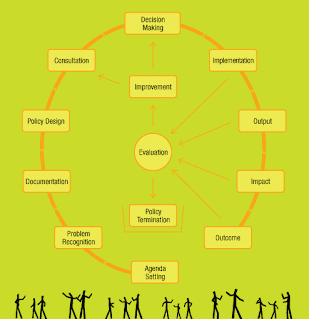Processes of Conceptualisation, Planning, Implementation, Monitoring, Evaluation | Public Administration Optional for UPSC (Notes) PDF Download
| Table of contents |

|
| Policy Formulation |

|
| Role of Bureaucrats in the Indian Context |

|
| Policy Implementation and Monitoring |

|
| Policy Education |

|
| Policy Evaluation and Review |

|
| Conclusion |

|
Policy Formulation
The process of policy formulation involves considering various options presented by different parts of society, such as interest and pressure groups, civil society, mass media, international organizations, and political parties. These options are used to create an agenda of potential issues that can be transformed into policies. Realistic goals and objectives are then established, and the legislature enacts these policies into law, granting them legal status and authority. Furthermore, strategies for implementation are devised, along with the necessary machinery to carry out the policies. However, limitations such as time constraints on the legislature, corruption, the infrequency of legislative sessions, and the need to address emergencies can hinder the policy formulation process.

Role of Bureaucrats in the Indian Context
In the Indian context, bureaucrats play a crucial role in policy formulation due to their extensive information base, knowledge, experience, and advisory expertise in policy matters. Middle-level bureaucrats, typically ranked three and four from the top, are actively involved in filling in the details of draft bills and proposed amendments. Their proposals are then scrutinized by top-level bureaucrats, who are closer to the ministers. The top-level bureaucrats may accept the proposals as is or with alterations, or they may send them back for changes or adjustments while making policy decisions. In some cases, top-level bureaucrats also act as executors, correcting the draft proposals sent to them by their subordinates and submitting them to the minister for approval.
Policy Implementation and Monitoring
The implementation stage involves developing machinery and strengthening bureaucracy to execute the selected policies. It includes ensuring the availability of knowledgeable and skilled personnel, establishing appropriate organizational and infrastructural setups, and utilizing technology, technical support, and financial aid. Administrators make decisions at each stage to select the best alternatives for carrying out the assigned tasks. Mid-term appraisals are conducted to assess policy development, and senior officers monitor and guide junior officials throughout the implementation process to minimize errors. However, limitations such as bureaucratic inefficiencies (nepotism, red tape, etc.), rigid behavior of administrators, lack of expertise and knowledge, insufficient funds and infrastructure, and lack of citizen cooperation can impede policy implementation.
Policy Education
Policy education aims to create awareness among the people and target groups about the objectives and benefits of policies, both in the present and future. This awareness helps garner public support, ensuring smoother implementation without major obstacles. Increased public participation in the policy process facilitates genuine feedback and helps curb nepotism and corruption during implementation. It also assists administrators in decision-making and improving policy implementation, thereby reducing potential conflicts. Nevertheless, limitations such as the lack of trust in bureaucracy and a hostile attitude between the people and administrators can hinder effective policy education.
Policy Evaluation and Review
Policy evaluation is a crucial step to assess the success and failure of policies. Evaluation takes into account factors such as cost-benefit analysis, people's welfare, and the achievement of set goals and objectives. Various stakeholders, including the legislature, bureaucracy, judiciary (through judicial review powers), and voluntary and nonprofit organizations, contribute significantly to policy evaluation. Policy studies play a vital role in reviewing policies and suggesting improvements. However, limitations such as a lack of will, resources, and data, as well as ambiguous policy statements and dilemmas related to equity or economics, can impede effective policy evaluation.
Conclusion
The policy cycle involves multiple stages, including formulation, implementation, education, and evaluation. Each stage has its own set of limitations that can hamper the effectiveness of the overall process. Addressing these limitations, such as time constraints, corruption, bureaucratic inefficiencies, lack of expertise and funds, trust issues, and data challenges, is crucial for achieving successful policy outcomes. By understanding and mitigating these limitations, policymakers can strive to create and implement policies that are responsive to societal needs, transparent, and capable of delivering the intended benefits to the people.
|
58 videos|242 docs
|















